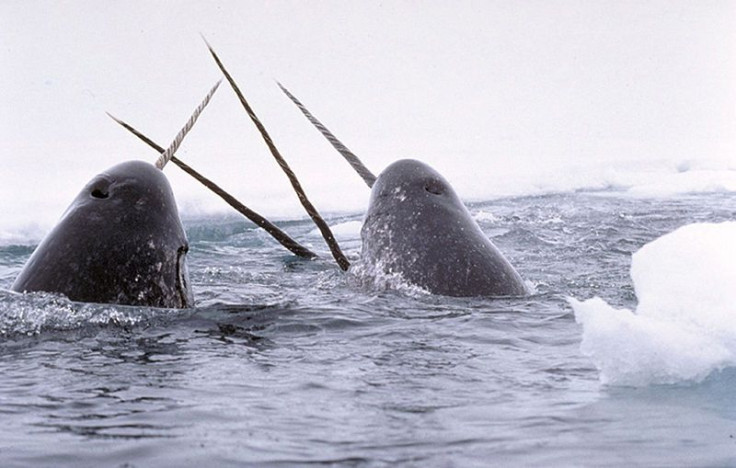Narwhal Tusk Mystery Solved? Study Finds Ocean Unicorn’s Overgrown Tooth Is Filled With Nerves

The purpose of the narwhal’s mighty tusk has long been an enigma. Scientists have their hunches as to why narwhals grow an exaggerated tooth, some of which can reach up to 9 feet in length, but because it’s difficult to observe narwhals in their natural environment, none of their theories really hold water. Is it a kind of biological ice pick? A way to attract mates? Or is it nothing more than a genetic abnormality? An international team of researchers thinks it has an answer.
According to a new study published in the journal The Anatomical Record, a narwhal’s tusk is a super sensitive probe that gathers information about the Arctic whale’s environment. Scientists believe the tusk, usually found only on males, can detect changes in the salinity of the water, a skill that might help the narwhal navigate the ocean or find food.
"People have said it's everything from an ice pick to an acoustic probe, but this is the first time that someone has discovered sensory function and has the science to show it," Martin Nweeia from the Harvard School of Dental Medicine, who was involved in the study, told The BBC.
Nweeia and his colleagues first proposed the narwhal-tusk-as-sensory-organ theory back in 2005, but it was met with some criticism from the scientific community. Kristin Laidre, a marine mammal biologist at the University of Washington in Seattle, told National Geographic there’s “zero evidence” to suggest the narwhal’s tusk can sense environmental changes.
But Nweeia demurs, saying that the analysis he and other researchers performed strongly hints at the narwhal tusk as a sensory organ. The team dissected several narwhal tusks they obtained from Inuit hunters near Baffin Island in the Canadian territory of Nunavut. Wired reports that researchers found a nerve-rich pulp inside the tusks similar to the stuff found in human teeth that makes us feel pain upon eating very cold ice cream or drinking hot coffee.
Their analysis revealed that the tusks’ outer layers are porous and that the inner layers have microscopic tubes that channel towards the center pulp. This would make the oversized tooth sensitive to temperature and chemical differences in the water, the study authors maintain.
Researchers also suited live narwhals with specialized “tusk Jackets,” which were basically plastic sheaths slipped over their tusks, and attached electrodes to the mammals to measure their heart rates. They then poured water containing varying levels of salt over the narwhals’ tusks.
They found that the narwhals’ heart rates increased when bathed in water with high salt concentrations. This could suggest that the narwhals sensed that the seawater was freezing and could trap them, given that high salt concentrations usually means the water is about to freeze.
Then again, couldn’t the narwhals’ rise in heart rate simply have indicated stress at being captured?
While the study is certainly fascinating, there’s probably more research that needs to be done. One thing’s for sure: the narwhal’s tusk continues to command our attention.
"If you were looking for an ideal and fascinating tooth to study there's no question this would be it." Nweeia told The BBC.
© Copyright IBTimes 2025. All rights reserved.






















